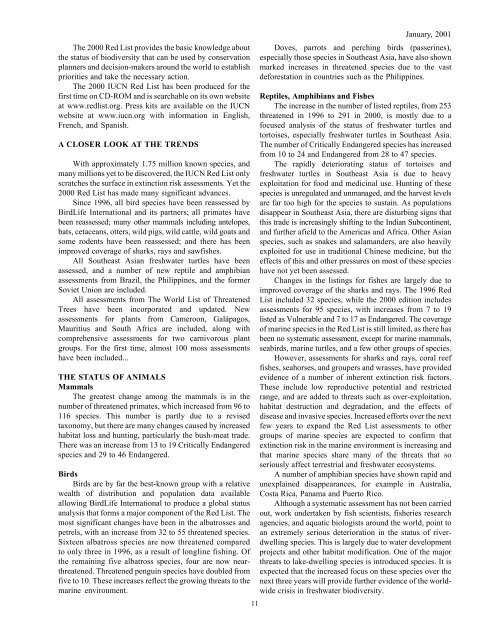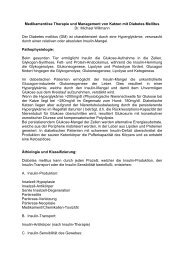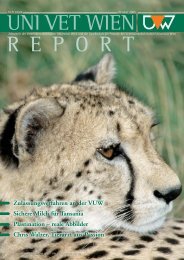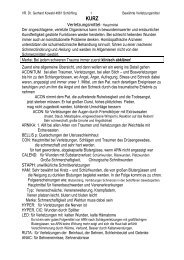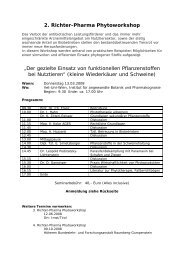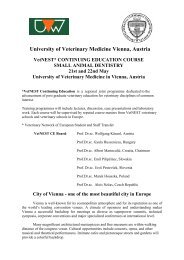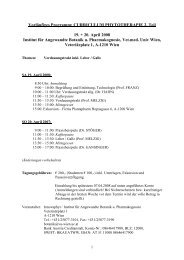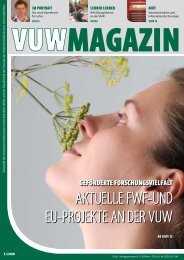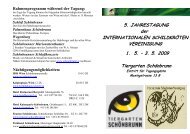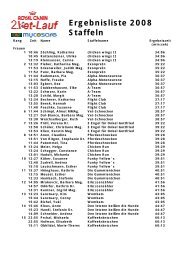Turtle and Tortoise Newsletter - VET-MAGAZIN.com
Turtle and Tortoise Newsletter - VET-MAGAZIN.com
Turtle and Tortoise Newsletter - VET-MAGAZIN.com
Create successful ePaper yourself
Turn your PDF publications into a flip-book with our unique Google optimized e-Paper software.
The 2000 Red List provides the basic knowledge aboutthe status of biodiversity that can be used by conservationplanners <strong>and</strong> decision-makers around the world to establishpriorities <strong>and</strong> take the necessary action.The 2000 IUCN Red List has been produced for thefirst time on CD-ROM <strong>and</strong> is searchable on its own websiteat www.redlist.org. Press kits are available on the IUCNwebsite at www.iucn.org with information in English,French, <strong>and</strong> Spanish.A CLOSER LOOK AT THE TRENDSWith approximately 1.75 million known species, <strong>and</strong>many millions yet to be discovered, the IUCN Red List onlyscratches the surface in extinction risk assessments. Yet the2000 Red List has made many significant advances.Since 1996, all bird species have been reassessed byBirdLife International <strong>and</strong> its partners; all primates havebeen reassessed; many other mammals including antelopes,bats, cetaceans, otters, wild pigs, wild cattle, wild goats <strong>and</strong>some rodents have been reassessed; <strong>and</strong> there has beenimproved coverage of sharks, rays <strong>and</strong> sawfishes.All Southeast Asian freshwater turtles have beenassessed, <strong>and</strong> a number of new reptile <strong>and</strong> amphibianassessments from Brazil, the Philippines, <strong>and</strong> the formerSoviet Union are included.All assessments from The World List of ThreatenedTrees have been incorporated <strong>and</strong> updated. Newassessments for plants from Cameroon, Galápagos,Mauritius <strong>and</strong> South Africa are included, along with<strong>com</strong>prehensive assessments for two carnivorous plantgroups. For the first time, almost 100 moss assessmentshave been included...THE STATUS OF ANIMALSMammalsThe greatest change among the mammals is in thenumber of threatened primates, which increased from 96 to116 species. This number is partly due to a revisedtaxonomy, but there are many changes caused by increasedhabitat loss <strong>and</strong> hunting, particularly the bush-meat trade.There was an increase from 13 to 19 Critically Endangeredspecies <strong>and</strong> 29 to 46 Endangered.BirdsBirds are by far the best-known group with a relativewealth of distribution <strong>and</strong> population data availableallowing BirdLife International to produce a global statusanalysis that forms a major <strong>com</strong>ponent of the Red List. Themost significant changes have been in the albatrosses <strong>and</strong>petrels, with an increase from 32 to 55 threatened species.Sixteen albatross species are now threatened <strong>com</strong>paredto only three in 1996, as a result of longline fishing. Ofthe remaining five albatross species, four are now nearthreatened.Threatened penguin species have doubled fromfive to 10. These increases reflect the growing threats to themarine environment.11January, 2001Doves, parrots <strong>and</strong> perching birds (passerines),especially those species in Southeast Asia, have also shownmarked increases in threatened species due to the vastdeforestation in countries such as the Philippines.Reptiles, Amphibians <strong>and</strong> FishesThe increase in the number of listed reptiles, from 253threatened in 1996 to 291 in 2000, is mostly due to afocused analysis of the status of freshwater turtles <strong>and</strong>tortoises, especially freshwater turtles in Southeast Asia.The number of Critically Endangered species has increasedfrom 10 to 24 <strong>and</strong> Endangered from 28 to 47 species.The rapidly deteriorating status of tortoises <strong>and</strong>freshwater turtles in Southeast Asia is due to heavyexploitation for food <strong>and</strong> medicinal use. Hunting of thesespecies is unregulated <strong>and</strong> unmanaged, <strong>and</strong> the harvest levelsare far too high for the species to sustain. As populationsdisappear in Southeast Asia, there are disturbing signs thatthis trade is increasingly shifting to the Indian Subcontinent,<strong>and</strong> further afield to the Americas <strong>and</strong> Africa. Other Asianspecies, such as snakes <strong>and</strong> salam<strong>and</strong>ers, are also heavilyexploited for use in traditional Chinese medicine, but theeffects of this <strong>and</strong> other pressures on most of these specieshave not yet been assessed.Changes in the listings for fishes are largely due toimproved coverage of the sharks <strong>and</strong> rays. The 1996 RedList included 32 species, while the 2000 edition includesassessments for 95 species, with increases from 7 to 19listed as Vulnerable <strong>and</strong> 7 to 17 as Endangered. The coverageof marine species in the Red List is still limited, as there hasbeen no systematic assessment, except for marine mammals,seabirds, marine turtles, <strong>and</strong> a few other groups of species.However, assessments for sharks <strong>and</strong> rays, coral reeffishes, seahorses, <strong>and</strong> groupers <strong>and</strong> wrasses, have providedevidence of a number of inherent extinction risk factors.These include low reproductive potential <strong>and</strong> restrictedrange, <strong>and</strong> are added to threats such as over-exploitation,habitat destruction <strong>and</strong> degradation, <strong>and</strong> the effects ofdisease <strong>and</strong> invasive species. Increased efforts over the nextfew years to exp<strong>and</strong> the Red List assessments to othergroups of marine species are expected to confirm thatextinction risk in the marine environment is increasing <strong>and</strong>that marine species share many of the threats that soseriously affect terrestrial <strong>and</strong> freshwater ecosystems.A number of amphibian species have shown rapid <strong>and</strong>unexplained disappearances, for example in Australia,Costa Rica, Panama <strong>and</strong> Puerto Rico.Although a systematic assessment has not been carriedout, work undertaken by fish scientists, fisheries researchagencies, <strong>and</strong> aquatic biologists around the world, point toan extremely serious deterioration in the status of riverdwellingspecies. This is largely due to water developmentprojects <strong>and</strong> other habitat modification. One of the majorthreats to lake-dwelling species is introduced species. It isexpected that the increased focus on these species over thenext three years will provide further evidence of the worldwidecrisis in freshwater biodiversity.


